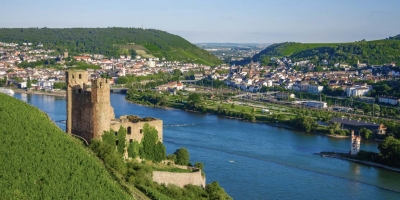Practically speaking
In today's global world, rivers offer orientation that have sometimes been lost in modern times and in everyday life.
Rivers have a beginning and an end, and those who stick to the riverside paths cannot stray from them.
The paths we follow are much older than we are and offer a special experience of space and time.
Rivers have always been lifelines and they were there long before humans settled on the banks of rivers.
Rivers will also be there when people have desettled the area.
Rivers meander from their source through picturesque landscapes, merge with other rivers to form large rivers and then flow into huge river deltas into the seas and oceans.
On both sides of the banks, rivers created habitats for humans and animals. A very varied flora and fauna developed along each river course.
The river offered people transport possibilities when there were no roads.
The river gave water and it transported dirty water.
The river offered protection from attackers from the other side.
and
The river was an energy source very early on (water and mill wheels).
Rivers are not only map entries - for a long time rivers were the symbols of borders and represented natural borders and cultural areas. Rivers were the scene of great and important battles for borders and expansions, some of which were decisive for the war, including the blasting of strategic bridges.
Rivers form waterways and economic axes and since the 15th century European monarchs and tsars have used the rivers and connected them with canals by means of science and architecture (old connecting canals even go back to antiquity in ancient civilizations). Thus new transport routes were created, which always brought new income and prosperity to the state and thus to the monarch.
All large capitals and residence cities were situated on the same river as Vienna, Budapest and Belgrade on the Danube. Prague on the Vltava. Dresden, Mageburg and Hamburg on the Elbe. Krakow and Warsaw on the Vistula. Rome on the Tiber, Paris on the Seine, London on the Thames and many more.
History of the rivers and settlement
Already the first advanced civilizations of Africa, the old Orient and in Asia originated at rivers. The Egyptian empire on both sides of the Nile, Mesopotamia at Euphrates and Tigris, the Harappa culture at the Indus and Chinese empires at Hwangho and Yangtsekiang.
The main reasons lay in the fertile alluvial soils, which the rivers left behind after floods in the floodplains on both sides of the rivers. Thus, collectors and hunters were able to settle down there to farm and raise cattle and to change or stop their nomadic existence. Food surpluses were achieved with the help of irrigation systems. Thus a good organization of the community was important to distribute land, water and surplus food fairly. In this way, state structures and cities were created on rivers with tight administration. Rivers such as the Nile were more important because they meant life. The Nile was even worshipped as a god by the Egyptian people.
From a philosophical point of view, rivers are already in ancient times the symbol for becoming and passing away and thus for human life.
From the young little stream that slowly accumulates power to the river that then merges with other rivers to form a stream and then the stream disappears into eternity of time and space.
The simultaneity of eternity and transience was a reason for the first baptisms on rivers in Christianity - as a promise of resurrection.
The river as the metaphor of human life - the direction of the flowing water, the water that takes life elsewhere.
In European antiquity, the symbolism of rivers is repeatedly emphasised - rivers have developed into cultural patterns over the centuries.



